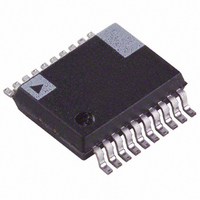ADE7756ARS Analog Devices Inc, ADE7756ARS Datasheet - Page 26

ADE7756ARS
Manufacturer Part Number
ADE7756ARS
Description
IC ENERGY METERING 1PHASE 20SSOP
Manufacturer
Analog Devices Inc
Datasheet
1.ADE7756AN.pdf
(32 pages)
Specifications of ADE7756ARS
Rohs Status
RoHS non-compliant
Input Impedance
390 KOhm
Measurement Error
0.1%
Voltage - I/o High
2.4V
Voltage - I/o Low
0.8V
Current - Supply
3mA
Voltage - Supply
4.75 V ~ 5.25 V
Operating Temperature
-40°C ~ 85°C
Mounting Type
Surface Mount
Package / Case
20-SSOP (0.200", 5.30mm Width)
Meter Type
Single Phase
Lead Free Status / RoHS Status
Not Compliant
Available stocks
Company
Part Number
Manufacturer
Quantity
Price
Company:
Part Number:
ADE7756ARSZ
Manufacturer:
AD
Quantity:
17 677
Part Number:
ADE7756ARSZ
Manufacturer:
ADI/亚德诺
Quantity:
20 000
ADE7756
SUSPENDING THE ADE7756 FUNCTIONALITY
The analog and the digital circuit can be suspended separately.
The analog portion of the ADE7756 can be suspended by set-
ting the ASUSPEND bit (Bit 4) of the Mode register to logic
high—see Mode Register section. In suspend mode, all wave-
form samples from the ADCs will be set to zeros. The digital
circuitry can be halted by holding the CLKIN input to 0 or 1.
The ADE7756 can be reactivated by restoring the CLKIN input
and setting the ASUSPEND bit to logic low.
SERIAL INTERFACE
All ADE7756 functionality is accessible via several on-chip
registers—see Figure 36. The contents of these registers can be
updated or read using the on-chip serial interface. After power-
on, or toggling the RESET pin low, on a falling edge on CS, the
ADE7756 is placed in Communications Mode. In Communications
Mode the ADE7756 expects a write to its Communications
register. The data written to the Communications register deter-
mines whether the next data transfer operation will be a read or
a write and also which register is accessed. Therefore all data trans-
fer operations with the ADE7756, whether a read or a write,
must begin with a write to the Communications register.
The Communications register is an 8-bit-wide register. The
MSB determines whether the next data transfer operation is a
read or a write. The 5 LSBs contain the address of the register
to be accessed. See Communications Register section for a more
detailed description.
Figure 37a and 37b show the data transfer sequences for a read
and write operation respectively.
On completion of a data transfer (read or write) the ADE7756
once again enters Communications Mode.
DOUT
SCLK
DOUT
DIN
CS
DIN
COMMUNICATIONS REGISTER WRITE
0
0 0 ADDRESS
COMMUNICATIONS REGISTER
REGISTER #n–1
REGISTER #1
REGISTER #2
REGISTER #3
REGISTER #n
MULTIBYTE READ DATA
OUT
OUT
OUT
OUT
OUT
IN
IN
IN
IN
IN
REGISTER
ADDRESS
DECODE
A data transfer is complete when the LSB of the ADE7756
register being addressed (for a write or a read) is transferred to
or from the ADE7756.
The Serial Interface of the ADE7756 is made up of four signals
SCLK, DIN, DOUT, and CS. The serial clock for a data trans-
fer is applied at the SCLK logic input. This logic input has a
Schmitt-trigger input structure, which allows slow rising (and
falling) clock edges to be used. All data transfer operations are
synchronized to the serial clock. Data is shifted into the ADE7756
at the DIN logic input on the falling edge of SCLK. Data is shifted
out of the ADE7756 at the DOUT logic output on a rising edge
of SCLK. The CS logic input is the chip select input. This input
is used when multiple devices share the serial bus. A falling edge
on CS also resets the serial interface and places the ADE7756 in
Communications Mode. The CS input should be driven low for
the entire data transfer operation. Bringing CS high during a data
transfer operation will abort the transfer and place the serial bus
in a high impedance state. The CS logic input may be tied low if
the ADE7756 is the only device on the serial bus. However,
with CS tied low all initiated data transfer operations must be
fully completed, i.e., the LSB of each register must be trans-
ferred as there is no other way of bringing the ADE7756 back
into Communications Mode without resetting the entire device,
i.e., using RESET.
Serial Write Operation
The serial write sequence takes place as follows. With the
ADE7756 in Communications Mode (i.e., the CS input logic
low), a write to the Communications register first takes place.
The MSB of this byte transfer is a 1, indicating that the data
transfer operation is a write. The LSBs of this byte contain the
address of the register to be written to. The ADE7756 starts
shifting in the register data on the next falling edge of SCLK.
All remaining bits of register data are shifted in on the falling
edge of subsequent SCLK pulses—see Figure 38.
As explained earlier, the data write is initiated by a write to the
communications register followed by the data. During a data
write operation to the ADE7756, data is transferred to all on-
chip registers one byte at a time. After a byte is transferred into
the serial port, there is a finite time before it is transferred to
one of the ADE7756 on-chip registers. Although another byte
transfer to the serial port can start while the previous byte is
being transferred to an on-chip register, this second byte trans-
fer should not finish until at least 4 µs after the end of the previous
byte transfer. This functionality is expressed in the timing speci-
fication t
a byte transfer (CS brought high), that byte will not be written
to the destination register.
Destination registers may be up to 2 bytes wide—see Register
Descriptions section. Hence the first byte shifted into the serial
port at DIN is transferred to the MSB (Most Significant Byte)
of the destination register. If the addressed register is 12 bits
SCLK
DIN
CS
COMMUNICATIONS REGISTER WRITE
6
—see Figure 38. If a write operation is aborted during
1
0 0 ADDRESS
MULTIBYTE WRITE DATA













